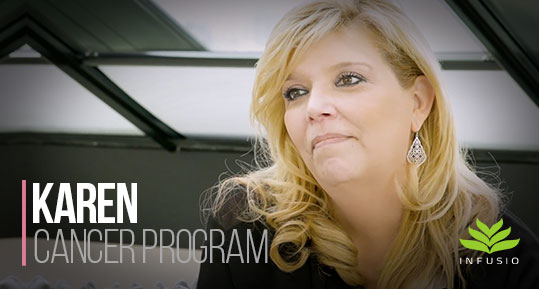
Give Liver Cancer a Double-Punch
A Revolutionary Minimally Invasive Cancer Treatment Option
Every October is Liver Cancer Awareness month! But wait, isn’t October Breast Cancer Awareness Month. The answer is yes. All through the month, look and you will see pink posters, pink billboards, pink ribbons, pink shirts, and a host of other pink items all in support of finding the cure for breast cancer. But have you seen anyone sporting any emerald green paraphernalia alerting others to “save the livers”? I didn’t think so. It turns out livers cannot compete with breasts. Who knew?
Liver Cancer is on the Rise
Liver cancer is not trending these days, but it is on the rise. In fact, liver cancer is one of the most common cancers worldwide and is the fastest-growing cause of cancer deaths. In a span of fifteen years, according to Cancer Treatment Centers of America, the number of annual diagnoses for liver cancer has increased by 75 percent worldwide. In the United States over the last twenty-five years, the number of annual liver cancer cases has tripled.
So even though liver cancer has not sparked any “every body needs a filter” campaigns or its own facial hair movement, it is a big deal.
There are several types of liver cancer. Hepatocellular carcinoma (HCC) a.k.a. hepatoma is the most common. Cases of HCC make up an estimated 75 percent of all liver disease cases.
So How Do You Treat Hepatocellular Carcinoma (HCC)?
The preferred method of treatment for hepatocellular carcinoma (HCC) is surgery or liver transplant. But there is a catch. Many patients are already showing signs of liver failure or permanent scarring (cirrhosis) before being diagnosed. Because of this and other factors, only a small group of patients are eligible for these preferred treatments. But there is good news. There are other options.
Two options should be very familiar to you: chemotherapy and radiation. If we were to play a morbid game of word association and the word was “cancer”, one could wager “chemo” and “radiation” to be among the most common responses. Let us consider them both.
Radiation
Radiation therapy uses high doses of radiation, be it externally or internally, to kill cancer cells. Radiation can break up critical components of a cell and leave them beyond repair. Cancer cells are going through growth stages at accelerated rates making them particularly vulnerable. The problem is radiation does not discriminate. All cells, cancerous or not, grow, multiply and divide meaning all cells are vulnerable. This makes radiation a poor option for patients who already have much liver damage – which is the majority of liver cancer patients.
Chemotherapy
With chemotherapy, drugs travel throughout the body and attack fast-growing cells. Cancer cells happen to be very fast growing. But they are not alone. The reason there is such a thing as a five-o-clock shadow is the same reason the face of a typical cancer patient is hairless. But more than cosmetic damage is done. Other normal cells such as bone marrow, the tissue responsible for blood cell production, are fast-growing. The fragile state of a HCC patient can be worsened by the unintended effects of chemotherapy.
So, while radiation and chemotherapy are viable options, they may not be the best.
A Minimally Invasive Liver Cancer Treatment Contender
TACE stands for a minimally invasive treatment called transarterial chemo embolization. And although you have probably never heard of it, it has over 30 years of history. It was designed specifically for cases of hepatocellular carcinoma (HCC) and can be adapted to suit individual patient’s needs and combined with other treatments such as immunotherapy.
Benefits of Treating HCC With TACE Include:
- Complication-free procedures
- Minimal stress for the patient
- Short hospital stay
- Slowing or reversing tumor growth
So what is transarterial chemoembolization? A straw-like tube called a catheter is inserted through the skin and into an artery feeding the tumor. Through the catheter, drugs are sent directly to the tumor. These drugs can be 100 times more concentrated than standard chemotherapy.
Why Can Dosage be so High While Not Killing the Rest of the Liver?
A liver is primarily fed blood through the portal vein and not through the arteries. The numbers are 75% and 25% respectively. In contrast, tumors get 95% of their blood supply through arteries. This is significant in that the majority of the liver will be spared effects from the chemotherapeutic drugs traveling through the arteries. Along with these drugs, agents to block blood flow to the tumor are delivered. This keeps anti-cancer drugs trapped in the tumor while also starving the tumor of its blood supply (embolization). This “double-punch” method slows or even reverses the growth of the tumor. This may open the way for the patient to be eligible for more treatment options. In fact, a starving shrinking liver cancer tumor in time may allow a patient to qualify for preferred curative treatments.
TACE can be combined with other supportive treatments such as Dendritic Cell Therapy, Regional Hyperthermia and IV therapy which can provide you with an integrative therapy plan to combat cancer from various angles.
Infusio is a unique, multi-level approach to healing, designed by British naturopath Philip Battiade for the treatment of chronic degenerative illnesses such as Lyme disease, autoimmune disorders, neurological disorders and cancer. The framework of the Infusio Concept consists of the Five Steps To Health, a foundational system that helps determine each patient’s individual needs and then optimizes their health. Integrating the best of traditional European medicine, alternative medicine and cutting-edge science, offering services ranging from Bioenergetics to Stem Cell Therapy and rejuvenating spa treatments, Infusio provides a 360° individualized approach to health.Chronic Disease Health TipsChronic Disease TipsHealth TipsTips for People with Chronic Illness
Resources:
Resources:
https://www.ncbi.nlm.nih.gov/pmc/articles/PMC3433134/
https://www.ncbi.nlm.nih.gov/pmc/articles/PMC5083790/
https://www.hopkinsmedicine.org/interventional-radiology/procedures/chemoembolization/
https://www.cancercenter.com/cancer-types/liver-cancer/about
https://www.urmc.rochester.edu/encyclopedia/content.aspx?contenttypeid=34&contentid=17909-1




